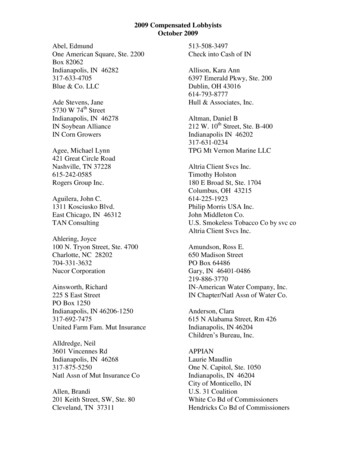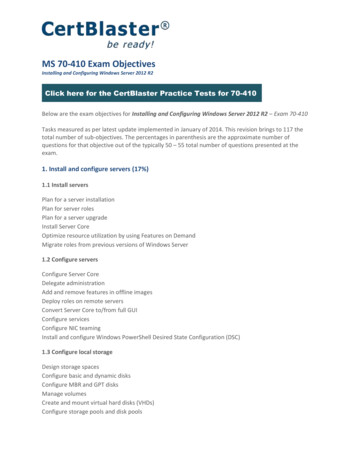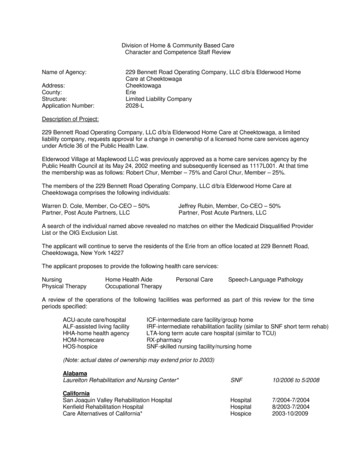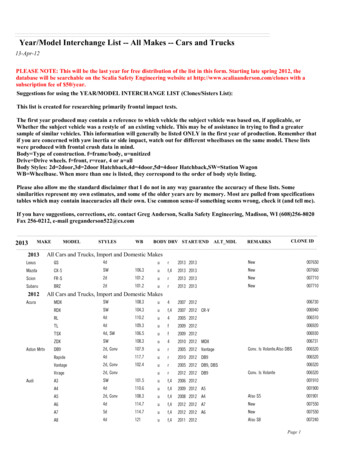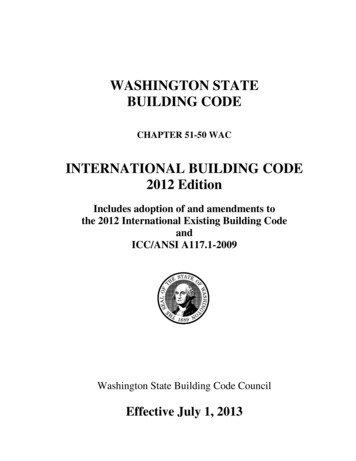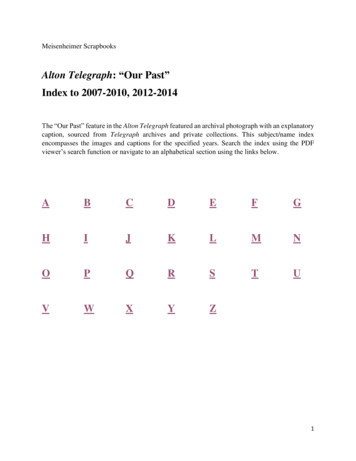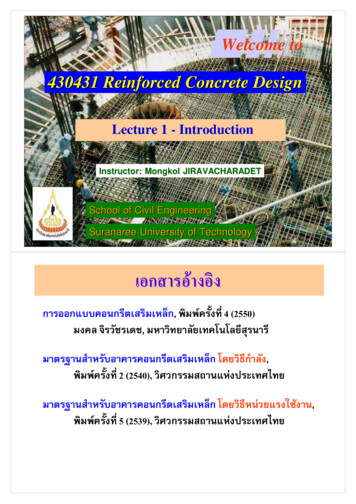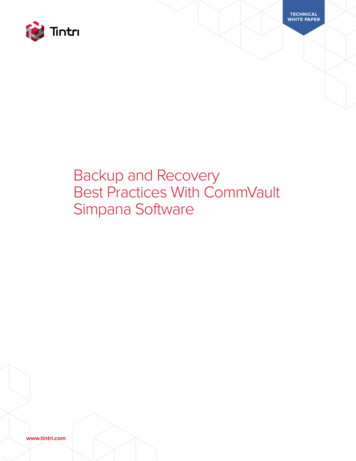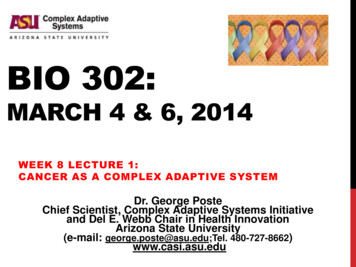
Transcription
BIO 302:MARCH 4 & 6, 2014WEEK 8 LECTURE 1:CANCER AS A COMPLEX ADAPTIVE SYSTEMDr. George PosteChief Scientist, Complex Adaptive Systems Initiativeand Del E. Webb Chair in Health InnovationArizona State University(e-mail: george.poste@asu.edu;Tel. 480-727-8662)www.casi.asu.edu
Cancer as a Complex Adaptive System (CAS)Lecture 1 genotoxic insult(s), mutations and genomeinstability in cancer (drivers) the progressive evolution of phenotypicheterogeneity in different clones within tumors selection pressures on clonal fitness, adaptation andthe evolution of the metastatic process tumor progression as a complex co-evolutionaryinteraction between dynamic changes in tumorbehavior and host responses
Genotoxic Insult(s), Mutations and Genome Instability:The Drivers of Tumor Initiation and Progression
The Lengthy Timeframes for Progressionin Different Human Cancers
Cancer Genomes: A Formidably Complex Catalog ofGenomic Changes and Molecular Network Disruptions
Cancer Genes Identified in 4,742 Human TumorsM. S. Lawrence et al. (2014) Nature 505, 495
Copy Number Alteration in 5135 Tumors from 14 Solid Tumor TypesFrom: G. Iyer et al. (2013) JCO 31, 3133
Genotoxic Insult(s), Accumulation of Mutations andProgressive Genome Instability
The Prevalence of Somatic MutationsAcross Human Cancer TypesFrom: L. B. Alexandrove et al. (2013) Nature doi:10.1038/nature12477
Somatic Mutation Prevalence in Different CancersNature (2013) doi.1038/nature 12477 survey of 5 million mutations from over 7000cancer cases from 30 different cancer types highly variable mutation load– 0.001 per DNA megabase (Mb) to 400 per Mb childhood cancers carry fewest mutations cancers related to chronic mutagenic exposureexhibit highest mutation burden– lung cancer (tobacco expose), malignantmelanoma (UV exposure)
Histopathologic Classification of Disease
The Shift from Cancer Diagnosis by Histopathologyto Molecular Profiling of Perturbed Gene Networks andAltered Molecular Signaling PathwaysDifferent Tumor Subtypes Arise in the Same Cell Lineagevia Different Genomic Perturbations and Alterationsin Molecular Signaling Networks
The Evolution of the Classification ofNon-Small Cell Lung Cancer (NSCLC)From: T. Li et al. (2013) JCO 31, 1039
Emergence of Different Tumor Cell Clonesand Subclones with Tumor Progressioncontinued accumulation of genomic alterationsgenerates cancer cell clones and subcloneswith different genomic alterations andphenotypes (heterogeneity)
Emergence of New Clones With Different Phenotypes(Heterogeneity) During Tumor Progressioninitiation/promotion chemical virus hormone nutritionbase stateselectiontumor progression and clonal ationsmutationclonaldiversificationemergenceof Dr and/orimmune escapevariantsAdapted from A. Barker and K. Buetow
Intratumor Genetic Heterogeneity in Multiple Regions of Primary ClearCell Tumor and Three Metastases (Perinephric and Chest Wall) in RCCFrom: M. Gerlinger et al. (2012) NEJM 366, 883
Intra-Lesional Variation in Somatic Gene Rearrangementsin Three Treatment-Naïve Stage III/IV Epithelial Ovarian Cancer PatientsAdapted From: M. Hoogstraat et al. (2014) Genome Res. 24, 200
Clonal Heterogeneity in Cancer intratumoral (same patient)– ‘zonal’ heterogeneity in primary tumor– presence of different clones in separatemetastases inter-patient variation (same subtype of tumorin different patients)
Genome Instability in Cancer continued accumulation of genomic alterationsand generation of clones and subclones withdifferent genomic alterations and phenotypesCLONAL HETEROGENEITY IN CANCER:THE LARGEST OBSTACLE TOSUCCESSFUL THERAPY
Tumor Cell Heterogeneity:The Omnipresent and Greatest Challenge in Cancer Therapy
Tumor Cell Heterogeneity:The Omnipresent and Greatest Challenge in Cancer TherapyXXXXXX XXXXXMore details Lecture Week IIX
Cancer as an Evolutionary ProcessClonal Selection (Fitness): Robustness, Adaption and Evolvability continuous acquisition of heritable geneticvariation in individual tumor cells and generationof clonal progeny action of natural selection on the resultingphenotypes (selection and fitness) cumulative acquisition and selection of traits thatconfer autonomous unlimited replication, highsurvival and eventual progression to invasionand disseminated metastasis
The Complex Phenotypes for Cancer CellSurvival and MetastasisFrom: J. Luo et al. (2009) Cell 136, 823
Genome Instability in Cancer tumor initiation and progression via accumulationof mutations and other genomic alterations thatconfer selective growth advantage driver mutations passenger mutations
Making Sense of Cancer Genomic Datadriver mutations oncogenes suppressor genes
CancerOncogeneActivation overdriveof positivegrowth signalsTumor SuppressorGene Inactivation escape fromgrowth controlsignals fornatural tissuehomeostasis
Cancer:Unchecked ProliferationOncogene ActivationandOncogene “Addiction” “activating” (gain-of-function) mutations inproto-oncogenes freedom from the negative feedback thatimpose control on proliferation in normaltissues prototypic examples: RAS, PI3-kinase, MYC,RAF
Multiple Mechanisms for Activation of Oncogenes
Chromosomal Rearrangements and Gene Fusions in Cancer fusion of oncogeneswith a second geneAdapted From: T. H. Rabbitts et al.(2009) Cell 137, 391
Activation of Different Oncogenes in CancersArising in the Same Cell Type(Tumor Subtypes)
Heterogeneity of Driver Oncogenes in NSCLCFrom: T. Mitsudomi et al. (2013) Nat. Rev. Clin. Oncol. 10, 235
Frequencies of Molecular Alterations in CRCand Responsiveness to Cetuximab or PanitumumabFrom: M. Martini et al. (2012)Nature Rev. Clin. Oncol.
Two Classes of Tumor Suppressor Genesgatekeepers normally act to restrain cell proliferation loss of function mutations can lead toexcessive proliferation/tumor formation– e.g. RB, NF2, TP53 and PTENcaretakers normally function in DNA repair and chromosomesorting loss of function mutations contribute to genomicinstability- e.g. APC, BRCA1, BRCA2
Cancer Predisposition GenesRetinoblastoma (RB)Adenomatosis Polyposis Coli (APC)
BRCA 1 and 2 as Tumor Suppressor Genes:Different Mutations May Confer Different Risks substantially increasedlifetime risks of breast andovarian cancers but only smallrisk of increased pancreaticcancer loss-of-function mutations incentral gene region conferhigher risk of ovarian cancerversus breast cancer thanmutations at gene end regions
Making Sense of Cancer Genomic Datadriver mutations oncogenes suppressor genespassenger mutations changes in genome and gene regulatorynetworks that are not causal for cancerinitiation and progression accumulate with increasing genomeinstability as tumor progresses may still contribute to adaptive survivaladvantage drug efflux transporters
How Does Genome Instability Generatethe Complex Behavior (Phenotypes) of Tumor Cells?Immunoevasion, Metastasis and Drug Resistance as theThree Most Clinically Relevant (and Dangerous) Phenotypesin Cancer Cell BehaviorUnderstanding the Altered Molecular Signaling Networks thatDrive These Aspects of Tumor Behavior and asTargets for Diagnostics (Dx) and Therapeutics (Rx)
Molecular MedicineDefining Disease Mechanisms at the Molecular LevelMapping the Disruption of Molecular Signaling NetworksProfiling Altered Patterns of Information Flowin Signaling Pathways and Understanding Their Contributionto Disease Requires A Systems-Based Approach
Genes For .The Overly Simplistic and Deterministic Dangers of aGenome-Sequence Centric PerspectiveThe Over-Simplified Perspective ThatWhole Exome-and Whole Genome-SequencingWill Reveal the Full Etiology of Disease Pathogenesisand Transform Treatment Options
Profiling Changes in Biological Signaling Networks in Cancer:Understanding Cancer Requires a Holistic “Systems” Approach genome sequence data alone will not provide asufficiently complete picture for either Dx or Rxdecisions– need to understand cancer as a complexmulti-component process mapping disruption in signaling pathways requiresprofiling of multiple aspects of both genotypic andphenotypic changes
Elucidation of Disease Mechanisms Will Require More thanGenome Sequence Information: The Need for ComprehensiveKnowledge of Disruption of Gene Regulatory Networksprimary genome sequence mutationsamplifications, deletions, copy number variationchromosomal translocationsaneuploidyepigenetic modificationsthe non-coding transcriptome and gene regulation the increasing complexity of regulation of geneexpression by diverse RNA species
The Epigenome:Reading The Second Genomic Code chromatin structure and access toDNA DNA methylation
Epigenomethe epigenome dynamic modulation of gene expression withoutchange in the primary sequence of nucleotide bases regulation of gene expression (activation, silencing)by modification of chromatin structure and histones dynamic changes in cytosine methylationthe epitranscriptome dynamic and reversible chemical modification ofRNA– e.g. N6-methyladenosine
Epigenetic Gene Silencing***Epigenetic Gene Activation********green line expressed; red line silent;* DNA methylation
Growing Recognition of the Complexity of theRNA Universe in Regulating Gene Expression pervasive transcription of 90% of the genomewith less than 2% encoding protein-coding genes human transcriptome– 21,000 protein-coding genes– 9,000 small RNAs– 10,000-32,000 long non-coding RNAs (lncRNAs)– 11,000 pseudogenes extensive crosstalk and interactions betweendifferent RNA species
Post-Transcriptional Regulation of Gene Expressiongene transcript(s)messenger RNAribosomeblock bycompetitivemiRNAs capture of miRNAs (RNA sponges)by IncRNAs, competitiveendogenous (ceRNAs) andcircular RNAs (circRNAs)control ofprotein expressionlevels
Individual Variation, Genome Complexity and theChallenge of Genotype-Phenotype PredictionsJunk No More: Pervasive Transcription alternatetranscription/translation/(co)splicing SNPs, CNVs pseudogenes indels, SVs ncRNAs phasing epistasis imprinting silencingrecognition of thecomplexity of genomeorganization and regulationCell-specific MolecularInteraction NetworksPerturbed Networksand Disease
The Multiplicity of Genomic, Transcriptomic, Epigenomic and Signaling PathwayAlterations in AML Illustrate Why Genome Sequencing Alone is Only One Part ofthe Molecular Profile Needed for Guiding Diagnosis and TherapyFrom: S-J. Chen et al. (2013) Nature Genetics 45, 586
GBM Expression Subtypes and TF and miRNA-TF Regulatory NetworksFrom: M. S. Carro et al. (2010) Nature 463, 318From: PLoS Computational Biology (2012) Vol. 8, 7 e1002488
Canonical Molecular Signaling Networks andPathways and Dysregulation in Disease
The Complex Ecology of Tumor Progressionand MetastasisThe Tumor Microenvironment:Molecular Signaling Between Cancer Cells,Immune Cells and Tissue Components
The Complex Ecology of Malignant Neoplasms multiple cell types and inter-cellularmolecular communication activities in thetumor microenvironment(s) tumor cell-tumor cell interactions tumor cell-host stroma interactions tumor cell-host defense interactions tumor cell-host interactions in differentbody organ environments for successfulmetastasis effect of treatment(s) on tumor cells, hostdefense systems and the host microbiome
The Complex Microenvironment of NeoplasmsFrom: A. R. A. Anderson and V. Quaranta (2008) Nature Reviews Ca. 8, 227
From L. J. Kleinsmith, Principles of Cancer Biology.Copyright (c) 2006 Pearson Benjamin Cummings.
Reprogramming Energy Metabolism in Cancer CellsThe Warburg Effect pioneering work of Otto Warburg (1927) normal dominance of oxidative metabolismunder aerobic conditions (Krebs cycle) normal cells shift to glycolysis under anaerobicconditions– redirect pyruvate away from mitochondrialoxidation to reduce pyruvate to lactate tumor cells metabolize glucose to lactate inboth aerobic and anaerobic environments– support survival and proliferation inmicroenvironments with limited oxygenation(hypoxia) due to impaired vascular supply
Reprogramming Energy Metabolism in Cancer Cells possible role of reactive oxygen species (ROS)released by tumor cells in causing tumorassociated host fibroblasts to switch to aerobicglycolysis– increased production of lactate and pyruvate asmetabolites to fuel cancer cells similar reprogramming of adipocytes in fat tissue– production of free fatty acids (FFA) as tumornutrients
Pro-Inflammatory Host Responsesand Promotion of Tumor Growth insufficient blood supply, hypoxia, increasedacidity and impaired nutrient supply in growingtumors trigger necrosis and release ofpro-inflammatory signals– stimulus to recruit host immune cells whothen release further pro-proliferation signalsexploited by tumor cells to promote survivaland progression
The Tumor Microenvironment Hijacking:Host Responses by Tumor Cells toPromote Proliferation and Progression tumors secrete growth factors andchemoattractants for host inflammatory andimmune cells pro-inflammatory cytokines released by these hostcells promote tumor progression– suppress apoptosis– promote cell cycle progression/cell replication– angiogenesis– induce epithelial-mesenchymal transition (EMT)markers
The Tumor MicroenvironmentFrom: Ray-Coquard Future Oncol. (2013) 9, 12 Suppl. 1, 11
Tumor-Mediated Suppression ofHost Anti-Cancer Immune Responses tumors recruit T regulatory cells (Treg) andmyeloid-derived suppressor cells (MDSC) these host immune cells suppress the abilityof cytotoxic killer T cells to detect and destroytumor cellsMore Details inLecture Week II
Invasion and Metastasis:The Start of the Deadly Phase of Cancer Progressionbasal ateInvasion WithoutMetastasisInvasion and Metastasis
Macrophages and the TumorMicroenvironment tumor-associated macrophages (TAM) switch of macrophages from M1 to M2phenotype in normal inflammation and thenswitch back in tumors and obesity macrophages remain inM2 state role of TAM in early steps in metastasis(intravasation)
A Perverse Molecular Conversation:Tumor Cell Signals That Stimulate HostMacrophages to Promote Tumor Growth and Spread1. Cancer cellreleasesmicrovesicles thatcontain miRNA-21and miR-29.4. Cancer cellstake up IL-6/TNFalpha,facilitatingtumor invasionand metastasis.2. Macrophagestake up themicrovesiclesreleasing miR-21and miR-29 intothe cytoplasmwhere they aretaken up byendosomes.3. In the endosome,miR-21 and miR29 bind with toll likereceptors, causingthe macrophageto release interleukin 6 (IL-6)and tumor necrosisfactor (TNF) alpha.Adapted from Frontiers: OHSU James CCC Winter 2014
Entry of Metastatic Cancer Cells Into The Circulation (Intravasation)and Promotion by Tumour-Associated MacrophagesFrom: N. Raymond et al. (2013) Nature Rev. Cancer 13, 861
Tumor Cell- Platelet Interactions in PromotingDissemination and Extravasation protect against lysis by NK cells; increase adhesion toendothelial cells; recruitment of WBC that release proinflammatory cytokinesFrom: N. Raymond et al. (2013) Nature Rev. Cancer 13, 863
The Plasticity of Epithelial Cancer Cells:Switching (Transition) Between Epithelial and Mesenchymal PhenotypesEpithelial: Mesenchymal Transition (EMT) and Mesenchymal: EpithelialTransition (MET) as Core Features of Metastatic Spread and Tumor Dormancy
Formation of the Germ Layers in Embryogenesis:Endoderm, Mesoderm and EctodermHow to reset a cell reset-cell
Migration of Neural Crest Cells and Formation ofDifferent Cell Types in Multiple Body LocationsNeural Crest-derived Stem Cellsweb.biologie.uni-bielefeld.de -
Epithelial (E)- Mesenchymal (M) Transition (EMT) acquisition of M-like properties by E cells physiological processes– migration of mesodermal cells during embryonicgastrulation– delamination of neural crest cells from dorsalneural tube– migration to multiple locations and subsequentdifferentiation into diverse cell lineages cancer– proposed crucial role in invasion and metastasisof epithelial malignancies– potential for repeated cycles of EMT and reversal(MET)
The Epithelial-mesenchymal Transition inthe Invasion and Metastasis of Malignant Epithelial CancersFrom: W. L. Tam and R. A. Weinberg (2013) Nature Medicine 19, 1438
Principal Patterns of Metastatic Disseminationin the Major Epithelial Cancers
“The Seed and Soil Hypothesis” of Metastasis“When a plant goes to seed, its seeds are carried in all directions;but they can only live and grow if they fall on congenial soil While many researchers have been studying ‘the seeds,’the properties of ‘the soils’ may reveal valuableinsights into the metastatic peculiarities of cancer cases.”Stephen Paget 1889
Cancer Metastasis: Key Questions what determines the different anatomic distributionof solid tumor metastases? is every cancer cell in a malignant tumor capable ofcausing metastases? is metastatic capability a property of only certain cellsubpopulations/clones present in the primarytumor? do cells in metastases continue to spread(secondary metastases)? are future sites of metastatic colonization ‘primed’by host cells to promote conditions for metastaticcell survival?
Tumor Dormancy Versus Metastatic ProgressionFig. 3Fig. 2From: D. F. Quail & J. A. Joyce (2013) Nature Med. 19, 1423
Summary and Key Points
Cancerdeterminantsof SELECTIONemergence of clones withdiverse genotypes and phenotypeswith tumor progressionand metastasisHETEROGENEITYgenotoxic insult(s), genome instabilityand dysregulation of molecular signaling networksin different cell typesDRIVERS
CancerDynamics ofHost: TumorCo-evolutionand Rx-EffectsIntra-andInter-patientVariationWithin SameTumor SubtypeTumorSubtypes inthe SameCell Typedeterminantsof SELECTIONHETEROGENEITYemergence of clones withdiverse genotypes and phenotypeswith tumor progressionand metastasisgenotoxic insult(s), genome instabilityand dysregulation of molecular signaling networksin different cell typesDRIVERS
CancerSustained Tumor Growth,Progression and Metastasisand Resistance to TreatmentDynamics ofHost:TumorCo-evolutionand Rx-EffectsIntra-andInter-patientVariationWithin SameTumor SubtypeTumorSubtypes inthe SameCell Typedeterminantsof SELECTIONemergence of clones withdiverse genotypes and phenotypeswith tumor progressionand metastasisHETEROGENEITYgenotoxic insult(s), genome instabilityand dysregulation of molecular signaling networksin different cell typesDRIVERS
The ‘Fitness’ of the Metastatic Clone:“The Decathlon Phenotype” survival in the primary tumorinvasion of surrounding tissueepithelial-mesenchymal transitionintravasationsurvival in the circulationextravasationcolonization of new metastatic sitemesenchymal-epithelial transitionevasion of destruction by host immune defensesresist therapeutic assaults
Sustained Tumor Growth,Progression and Metastasisand Resistance to TreatmentDynamics ofHost:TumorCo-evolutionand Rx-EffectsIntra-andInter-patientVariationWithin SameTumor SubtypeTumorSubtypes inthe SameCell Typedeterminantsof SELECTIONemergence of clones withdiverse genotypes and phenotypeswith tumor progressionand metastasisHETEROGENEITYgenotoxic insult(s), genome instabilityand dysregulation of molecular signaling networksin different cell typesDRIVERS
Cancer as a Complex Adaptive System (CAS)Lecture 2 mapping the dynamics of the evolution of cloneswith genotypic and phenotypic differences(heterogeneity) during progressive tumor growthand metastatic spread how knowledge of the co-evolution of tumorbehavior and host responses is essential to designimproved diagnostic and therapeutic approaches incancer
CANCER AS A COMPLEX ADAPTIVE SYSTEM Dr. George Poste . From: M. S. Carro et al. (2010) Nature 463, 318 From: PLoS Computational Biology (2012) Vol. 8, 7 e1002488 . Canonical Molecular Signaling Networks and Pathways and Dysregulation in Disease . . From L. J. Kleinsmith
